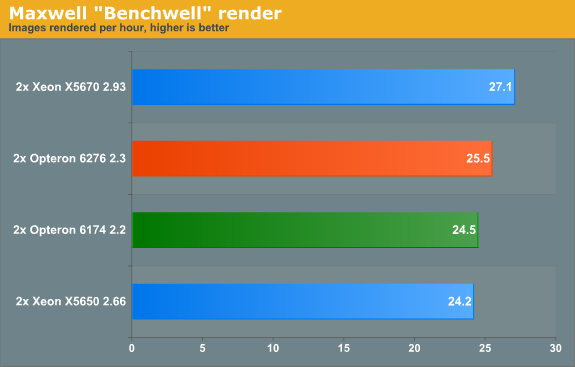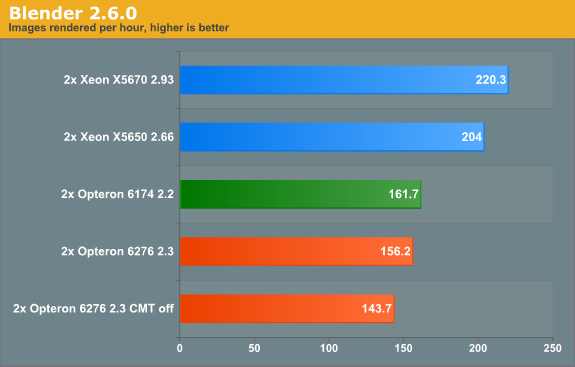Bulldozer for Servers: Testing AMD's "Interlagos" Opteron 6200 Series
by Johan De Gelas on November 15, 2011 5:09 PM ESTMaxwell Render Suite
The developers of Maxwell Render Suite--Next Limit--aim at delivering a renderer that is physically correct and capable of simulating light exactly as it behaves in the real world. As a result their software has developed a reputation of being powerful but slow. And "powerful but slow" always attracts our interest as such software can be quite interesting benchmarks for the latest CPU platforms. Maxwell Render 2.6 was released less than two weeks ago, on November 2, and that's what we used.
We used the "Benchwell" benchmark, a scene with HDRI (high dynamic range imaging) developed by the user community. Note that we used the "30 day trial" version of Maxwell. We converted the time reported to render the scene in images rendered per hour to make it easier to interprete the numbers.

Since Magny-cours made its entrance, AMD did rather well in the rendering benchmarks and Maxwell is no difference. The Bulldozer based Opteron 6276 gives decent but hardly stunning performance: about 4% faster than the predecessor. Interestingly, the Maxwell renderer is not limited by SSE (Floating Point) performance. When we disable CMT, the AMD Opteron 6276 delivered only 17 frames per second. In other words the extra integer cluster delivers 44% higher performance. There is a good chance that the fact that you disable the second load/store unit by disabling CMT is the reason for the higher performance that the second integer cluster delivers.
Rendering: Blender 2.6.0
Blender is a very popular open source renderer with a large community. We tested with the 64-bit Windows version 2.6.0a. If you like, you can perform this benchmark very easily too. We used the metallic robot, a scene with rather complex lighting (reflections) and raytracing. To make the benchmark more repetitive, we changed the following parameters:
- The resolution was set to 2560x1600
- Antialias was set to 16
- We disabled compositing in post processing
- Tiles were set to 8x8 (X=8, Y=8)
- Threads was set to auto (one thread per CPU is set).
To make the results easier to read, we again converted the reported render time into images rendered per hour, so higher is better.

Last time we checked (Blender 2.5a2) in Windows, the Xeon X5670 was capable of 136 images per hour, while the Opteron 6174 did 113. So the Xeon was about 20% faster. Now the gap widens: the Xeon is now 36% faster. The interesting thing that we discovered is that the Opteron is quite a bit faster when benchmarked in linux. We will follow up with some Linux numbers in the next article. The Opteron 6276 is in this benchmark 4% slower than its older brother, again likely due in part to the newness of its architecture.











106 Comments
View All Comments
mino - Wednesday, November 16, 2011 - link
More workload ... also you need at least 3 servers for any meaningful redundancy ... even when only needing the power of 1/4 of iether of them.BTW. most cpu's sold in the SMB space are far cry from the 16-core monsters reviewed here ...
JohanAnandtech - Thursday, November 17, 2011 - link
Don't forget the big "Cloud" buyers. Facebook has increased the numbers of server from 10.000 somewhere in 2008 tot 10 times more in 2011. That is one of the reasons why the number of units is still growing.roberto.tomas - Wednesday, November 16, 2011 - link
seems like the front page write and this article are from different versions:from the write up: "Each of the 16 integer threads gets their own integer cluster, complete with integer executions units, a load/store unit, and an L1-data cache"
from the article: "Cores (Modules)/Threads 8/16 [...] L1 Data 8x 64 KB 2-way"
what is really surprising is calling them threads (I thought, like the write up on the front page, that they each had their own independent integer "unit"). If they have their own L1 cache, they are cores as far as I'm concerned. Then again, the article itself seems to suggest just that: they are threads without independent L1 cache.
ps> I post comments only like once a year -- please dont delete my account. every time I do, I have to register anew :D
mino - Wednesday, November 16, 2011 - link
I suits Intel better to call them threads ... so writers are ordered ... only if the pesky reality did not pop up here and there.BD 4200 series is an 1-chip, 4-module, 8(4*2)-core, 16(4*2)-thread processor
BD 6200 series is a 2-chip, 8(2*4)-module, 16(2*4*2)-core, 16(2*4*2)-thread processor
Xeon 5600 series is an (up to) 1-chip, 6-core, 12(6*2)-thread processor.
Simple as cake. :D
rendroid1 - Wednesday, November 16, 2011 - link
The L1 D-cache should be 1 per thread, 4-way, etc.The L1 I-cache is shared by 2 threads per "module", and is 2-way, etc.
JohanAnandtech - Thursday, November 17, 2011 - link
Yep. fixed. :-)Novality77 - Wednesday, November 16, 2011 - link
One thing that I never see in any reviews is remarks about the fact that more cores with lower IPC has added costs when it comes to licensing. For instance Oracle, IBM and most other suppliers charge per core. These costs can add up pretty fast. 10000 per core is not uncommon.....fumigator - Wednesday, November 16, 2011 - link
Great review as usual. I found all the new AMD opterons very interesting. Pairing two in a dual socket G34 would make a multitasking monster on the cheap, and quite future proof.Abour cores vs modules vs hyperthreading, people thinking AMD cores aren't true cores, should consider the following:
adding virtual cores on hyperthreading in intel platforms don't make performance increase 100% per core, but only less than 50%
Also if you look at intel processor photographs, you won't notice the virtual cores anywhere in the pictures.
While in interlagos/bulldozer you could clearly spot each core by its shape inside each module. What surprises me is how small they are, but that's for an entire different discussion.
MossySF - Wednesday, November 16, 2011 - link
I'm waiting to see the follow-up Linux article. The hints in this one confirm my own experiences. At our company, we're 99% FOSS and when using Centos packages, AMD chips run just as fast as Intel chips since it's all compiled with GCC instead of Intel's "disable faster code when running on AMD processors" compiler. As an example, PostgreSQL on native Centos is just as fast on Thuban compared to Sandy Bridge at the same GHz. And when you then virtualize Centos under Centos+KVM, Thuban is 35% faster. (Nehalem goes from 10% slower natively to 50% slower under KVM!)The compiler issue might be something to look at in virtualization tests. If you fake an Intel identifier in your VM, optimizations for new instruction sets might kick in.
http://www.agner.org/optimize/blog/read.php?i=49#1...
UberApfel - Wednesday, November 16, 2011 - link
Amazingly biased review from Anandtech.A fairer comparison would be between the Opteron 6272 ($539 / 8-module) and Xeon E5645 ($579 / 6-core); both common and recent processors.
Yet handpicking the higher clocked Opteron 6276 (for what good reason?) seems to be nothing but an aim to make the new 6200 series seem un-remarkable in both power consumption and performance. The 6272 is cheaper, more common, and would beat the Xeon X5670 in power consumption which half this review is weighted on. Otherwise you should've used the 6282 SE which would compete in performance as well as being the appropriate processor according to your own chart.
Even the chart on Page 1 is designed to make Intel look superior all-around. For what reason would you exclude the Opteron 4274 HE (65W TDP) or the Opteron 4256 EE (35W TDP) from the 'Power Optimized' section?
The ignorance on processor tiers is forgivable even if you're likely paid to write this... but the benchmarks themselves are completely irrelevant. Where's the IIS/Apache/Nginx benchmark? PostgreSQL/SQLite? Facebook's HipHop? Node.js? Java? Something relevant to servers and not something obscure enough to sound professional?